Studebaker’s history in the auto business is full of “what ifs”. For example, what if they never merged with Packard in the 1950s? Or what if the Avanti sold enough copies to help prevent the closing of U.S. manufacturing in the 1960s? It’s doubtful that the latter would have helped that much as the goal was only to build 20,000 copies a year – and less than 5,000 saw the light of day in 18 months. This 1963 supercharged edition of the Avanti is a project car that looks to have been languishing for some time. Located in Fairborn, Ohio, it’s rougher than it looks at first glance, but is available here on eBay where the bidding stands at just $1,775 with an unmet reserve. Thanks for another awesome tip, T.J.!
With a decline in demand for its popular compact, the Lark, Studebaker was looking for another Hail Mary by 1961. As the story goes, the concept of the Avanti was conceived on a cocktail napkin on an airplane and became a reality in less than 18 months. That required Studebaker to rely on its existing parts bin for the mechanical elements of the automobile and a fiberglass body for the exterior of the car. Bad luck combined with Studebaker’s precarious financial position resulted in only 4.643 Avanti’s being produced from mid-1962 through December 1963 when U.S. auto production was moved to Canada. Along with the Gran Turismo Hawk, the Avanti did not make the foray north of the border.
Stude’s 289 cubic-inch V8 powered the Avanti, which – when equipped with a supercharger – could produce as much as 275 hp. Noted as “R2”, 1,552 of the 1963 Avanti’s came so equipped and the seller’s forgotten project appears to be one of them. We don’t know much about this car, but it looks like a lot of its originality could still be there. The body wears white paint, but there’s a gouge in the driver’s side door which some new fiberglass could patch. The interior looks to be a mess, and from the pulled-up carpeting in the rear floorboards, this Studebaker has collected rust over the years.
The Avanti is one of those rare cars where production continued after the company went out of business. A couple of aspiring Studebaker dealers bought the name and tooling for the vehicle and began building the Avanti II in 1965, relying on Chevrolet hardware for the cars to run. There were no supercharged Avanti IIs. The reincarnated automobile would continue at least through 1982, yielding another 5,000 copies in the process.
This Avanti is going to need tons of work and love, but it should be a worthwhile effort. Especially if you can make the supercharger come to life again. We don’t know if the set-up is still complete or how difficult these parts are to come by for what would be the Avant’s 60th anniversary.
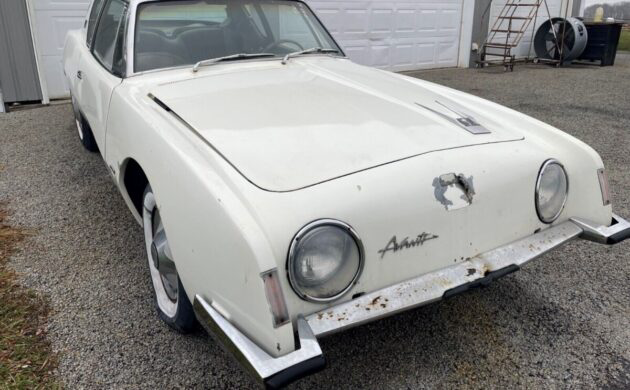
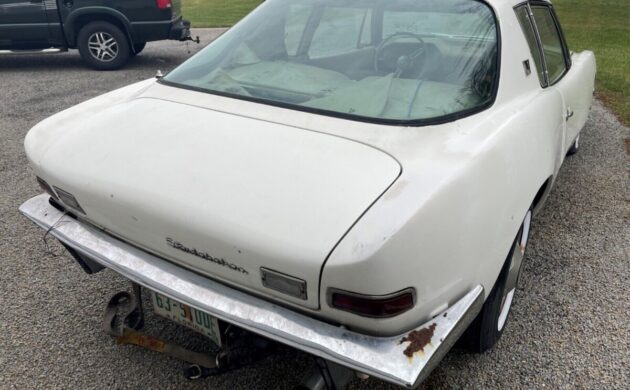
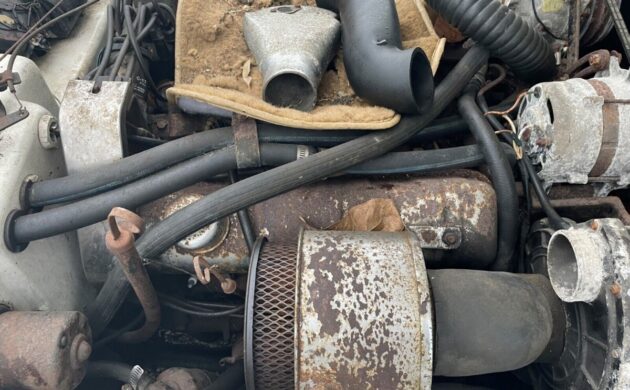
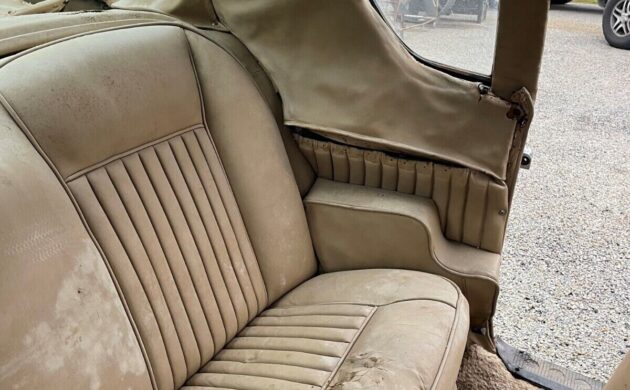
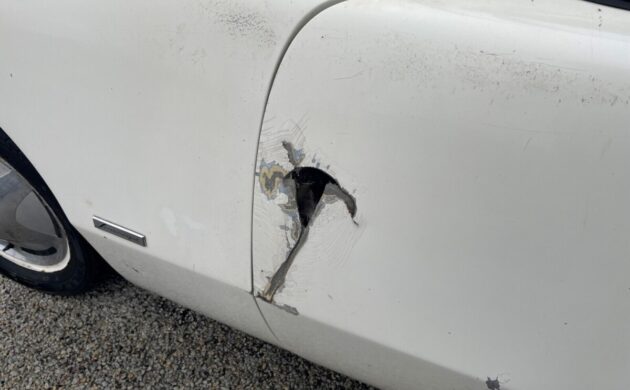

In my dreams I would love to take this on as a “RESTOMOD AVANT”I. In the real world, I think I will just keep dreaming.
LS swap !
With turbos !
💩
I won’t be cheap no matter how you go. There is no such thing as a cheap Avanti
Hey Vince, did you notice it’s a R-2 car with [aftermarket] air conditioning? I’ve always wanted a R-2 Avanti with A/C, but it also has to have a 4-speed. This is a little too far gone for me, especially when it needs the hog troughs replaced too.
I missed that one Bill.
If Studebaker had survived, it would be by far, the oldest company in existence. Many pioneers who ventured west, did so in covered wagons built by Studebaker, the original wagons pulled by the Budweiser Clydesdales were built by Studebaker. They were never on top, but fairly successful building cars and trucks through the years. Maybe merging with Packard drug them down, or maybe the funky body styling, the Hawk was a beautiful car, but a bit dated by the early 60s. The Lark put Studebaker on life support for a while, the Avanti was a last gasp effort for survival, but not much of one, never cared for these personally. Lack of funds and poor management wrote the final chapter to a long history.
The Packard “merger” was in fact Packard buying Studebaker. And Studebaker enabling it, and committing malfeasance, by supplying Packard’s people with cooked books. Studebaker hadn’t made money from 1952; and the years following, burned through their war profits. High cost-per-unit; generous labor contract, and one of the oldest active plants in the industry, pretty-much doomed it.
Packard had fantasies of running both brands; but while they were overpaying on Studebaker, Briggs Manufacturing, which made Packard bodies, was purchased by Chrysler. No more bodies after 1956.
Then, for some manufacturing reason, Packard bodies were found not able to be manufactured in South Bend. That left the Packardbaker route…and someone (probably James Nance, a non-auto man) decided it was silly to build Packard engines in Michigan and ship them to South Bend to assemble Packardbakers.
So ended the Packard marque.
Studebaker continued to lose money until the Lark briefly put them in the black in 1959. By then, Nance had been sacked; the Curtiss-Wright pairup had been done, not successfully, and a quiet boardroom decision was made to GET OUT of car manufacturing. Studebaker (dropping the hyphenated-Packard name) went on a buying spree – everything from STP, to Gravely lawn tractors, to Onan generators, to ALCO locomotives.
In came young, energetic Sherwood Eggbert – from McCullough. He was young industrial talent who no doubt could lead a diversified corporation.
Except, he found he LIKED the car business. The Avanti was his baby; and he got a reluctant OK from the directors. They would not endure it for long, though…Eggbert developed terminal cancer, and the Studebaker UAW contract came due in December 1963.
That was the end, except that Hamilton, Ontario was kept open to produce a token volume of Larks (the Lark name was dropped) to avoid paying damages to Studebaker dealers. They didn’t discontinue manufacturing; they just cut their product line to one car.
That worked, too. Studebaker dealers, one after another, gave up the franchise. Then, in 1966, the National Highway Safety Act was passed – and the decision was made, close Hamilton. Even though in its last two years it had made a small profit for the company.
Alright already, I was trying to keep it brief lol
Chrysler agreed to supply Packard with bodies through the 1954 model year. Nance was not fired, he resigned after realizing there would be no workable place for him working with Roy Hurley of CW. Hurley was just as driven and stubborn as Nance was. They would have butted heads for sure.
With all due respect, Yblocker, Hudson Bay Company predates Studebaker by about 200 years
and is still a (mostly) profitable entity.
I was referring to automobile companies.
There is no shortage of things to address in this Avanti. I’m wondering how many years ago the motor ran. There’s a good amount of body work as well as a complete interior needed. This is not a project for the faint hearted.
Was that air vent in the front fascia an option?
It was unfortunately selected after the car had already left the factory.
“For example, what if they never merged with Packard in the 1950s?”
They likely would have exited the car biz sooner as they were in worse financial shape than Packard in ’54. The so-called merger bought them a few more years at Packard’s expense.
To me, Avantis look better in photos than they do IRL.
man, how long was this sitting in the Maumee River before it was dredged out?
Hog troughs are rotted, original carb appears gone. What a basket case and money pit. I restored a 63 r1 20 years ago, and it wasn’t cheap then. Would be cheaper to buy a running car